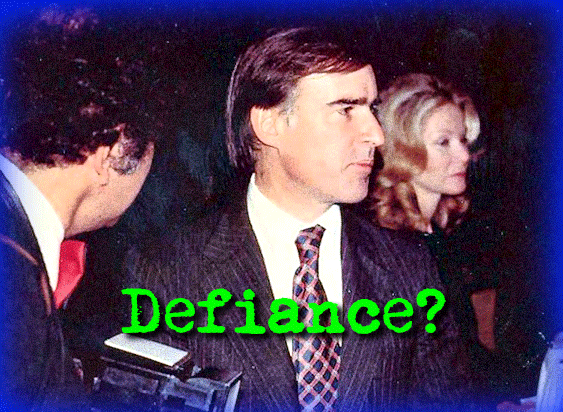GOV. BROWN’S DEFIANCE OF FEDERAL COURT ORDERS
The Atlantic’s Andrew Cohen, in a sharply-worded essay, says that Governor Jerry Brown is deeply and legally in the wrong in failing to comply the various court orders to lower California’s prison population. Here’s how Cohen’s essay opens:
Whatever happened to Jerry Brown? You know, the Jerry Brown who once studied to be a Jesuit priest. The Jerry Brown who once fought like a wildcat against the entrenched and the powerful on behalf of the powerless and the dispossessed. The Jerry Brown who once traveled to India and worked with Mother Teresa at her Home for the Dying. The Jerry Brown that conservatives (and others) once derided as “Governor Moonbeam.” The Jerry Brown who never made it as a national political figure because he was considered too much of a softie on law and order, crime and punishment.
That Jerry Brown, now the governor of California, has morphed into a 21st century version of a 1950s Southern governor.* He is currently in “direct defiance” of a series of federal court orders, including one from the Supreme Court, ordering him at last to ease unconstitutional overcrowding in California’s prisons. And the tactics he and his lawyers have employed to evade their obligations to the inmates — and to the nation’s judges — are those employed by Southern governors when they chose to disobey federal commands to desegregate their public schools. Delay. Obfuscation. Interposition. It’s all here again, like a bad dream.
(And if you didn’t happen to read James Fallow’s cover story on Governor Brown in the Atlantic, definitely do so here.)
NOTE: The photo above is from Brown’s first term as governor (1975-1878) when he was a fiscal conservative and social liberal, an incarnation that Andrew Cohen writes that he much prefered.
LAPD INTERNAL INVESTIGATION FINDS DORNER WAS “RIGHTFULLY” FIRED
The LAPD issued a report Friday that said the the firing of ex-LAPD officer Chris Dorner was justified. LAPD Chief Charlie Beck ordered an internal review to investigate Dorner’s claims of racism and misconduct after people inside and outside the department said that many of the problems Dorner wrote about in his manifesto were valid. (For previous WitnessLA posts on Dorner, go here and here.)
LA Times’ Joel Rubin has the story on the long-awaited report. Here are some clips:
Beck made the move after a chorus of critics from within the department and outside its ranks latched on to Dorner’s allegations, saying that although they condemned the killings, Dorner’s dark description of the agency rang true. That swell of harsh criticism, Beck and others feared, threatened to undo years of work by police and city officials to rehabilitate the department’s reputation after decades marked by abuses and scandal.
“I directed this review because I wanted to ensure that the Los Angeles Police Department is fair and transparent in all that we do,” Beck said Friday in a prepared statement. “All of us recognize that as a department we are not perfect; nonetheless, this report shows that the discharge of Christopher Dorner was factually and legally the right decision.”
[SNIP]The 39-page report, written by Gerald Chaleff, a former criminal defense attorney who serves as a special assistant to Beck, staunchly defended the decision to kick Dorner out of the LAPD. Police investigators at the time, Chaleff concluded, were right when they found that Dorner, then a rookie, fabricated a story in 2007 accusing his training officer of repeatedly kicking a handcuffed, mentally ill man.
Chaleff focused largely on the fact that Dorner waited nearly two weeks before he reported the alleged kicking to a supervisor and then offered conflicting explanations for the delay. For example, he at one point told investigators he trusted only one supervisor at his station and wanted to wait until he could report the abuse to him. Records, however, showed that the supervisor and Dorner worked the same shift on several days before he spoke up, the report found.
(There’s a lot more, so be sure to read the rest, and also check out Frank Stolze’s coverage on KPCC.)
MICHIGAN HIGH SCHOOL USES “CONFLICT RESOLUTION ROOM” TO FIGHT SUSPENSION RATE
A Michigan high school has seen a significant decline in suspensions over the last school year by employing “restorative justice” tactics like peer mediation to head off conflicts between students before they escalate. (It’s heartening to see schools across the US finding effective alternatives to harmful “zero tolerance” policies.)
KPCC’s Jennifer Guerra has the story. Here are some clips:
The “conflict resolution room” at Ypsilanti High School in Michigan is quiet and sparse — just a small couch, some chairs and a plant. For decoration there are a few homemade posters with drawings of shooting stars and signs with slogans like “Together we can!” and “Think before you speak.”
It’s where students go when they’re on the verge of being suspended.
[SNIP]Peer mediation is used as a prevention tactic to stop conflicts before they get too serious. But if a fight is about to break out or already has, that’s when Margaret Rohr, who runs the conflict resolution room, uses “restorative justice.”
“Restorative practices basically establish a complete paradigm shift from traditional discipline,” Rohr says.
With traditional discipline, the focus is on rules and punishment: Break rule X, get punishment Y. With restorative justice, Rohr explains, the focus is on harm done and relationships.
For instance, if a student starts a fight in the hall — normally grounds for suspension — Rohr will round up everyone who was harmed by the fight and have them participate in a restorative circle. The student who caused the harm has to listen as one-by-one he hears how his actions impacted those around him.
“It works,” says Mara Schiff, a professor at Florida Atlantic University, “because youth are empowered to take responsibility for their own behavior, to be held accountable for their own behavior and to make it right.”
Photo courtesy of Alan Light.

